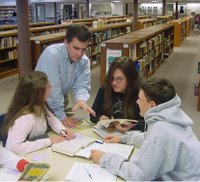How it can and how it should
Too many things percolating right now. Too often it is easy to view what I am discovering about Web 2.0 and teaching through the perspective of "Hey, look at what you can do..." Instead, I believe we need to frame it more with the perspective of "Hey, here is what you should do..." Where is that cutoff point of can and should? We need to purposefully and repeatedly ask ourselves how we can improve learning inside our classrooms with any - or all - of these new tools. For me, it has so far limited itself to using a blog to encourage more authentic student writing, maintaining a wiki to compile and share student ideas, and even incorporating an online calendar for my planning. Outside the classroom, I've experimented even more, little by little feeling comfortable enough to bring these collaborative, flat world tools into F14 at Branford High School. Will it be something like Skype or RSS feeds or social bookmarking? Or - more likely - will it be utilizing something I don't even know exists? Just forty eight hours ago, that was polldaddy, by the way.
More questions. When a majority of our colleagues get around to discovering the potential of the Web 2.0, what will they find? What is it out there that's truly something we should do? And if we should do it, then what do we need to do as a profession to make sure that it gets done?
I began by creating a blog and having the students post their homework to it in the comments section. In the process of doing that, I began reading more blogs and discovered the accessibility of other tools, specifically wikis, which next showed up in F14. Those two were easy. They have essentially replaced other word processing tools and mixed in some peer collaboration and the context of easily published writing.
This has been a sizable leap, but not seismic like it may seem for other teachers in my building. At the beginning of this school year the extent of my digital literacy was using PowerPoint and posting most of my materials on my website. Few other teachers regularly maintained a website. What I did, for the most part, seemed adequate for my classroom needs. My site consisted mainly of links to my materials, in the form of Word or PDF documents. There was usually a calendar posted regularly, a page of interesting/helpful links, and a resource page for my Literature Circles materials. Occasionally, I'd get an e-mail from a teacher in another state or country, who had stumbled across my site, thanking me expressing appreciation for ideas and supporting materials. To do that, required taking my classroom document from Word or wherever and posting it to the web page through a clunky process involving Microsoft Front Page and an ftp transfer. Other teachers in the building were generally impressed, but intimidated. "I don't know if I could do all that," they'd say, "I just want to have something simple for my class." (I look back now and shake my head, considering how much further along so many other teachers are, especially, for example, those listed to the right on my blogroll.) The problem is, they never took that first step that I did back in 2000. It takes time and has to be built slowly. I just read a post by Dana Huff, and she shares some of the same sentiments about technophobia that leave our profession moving at such a glacial pace when it comes to embracing new concepts and tools and keeping her teaching fresh. She says:
"I know how my classroom has transformed through my use of the SMART board, blogs, and wikis. I know it could transform others. I also know not everyone is patient enough to really learn how to use all of this technology, and that fact makes me sad."Citing an article in Teacher Magazine (registration required), Dana also writes that teachers who stay fresh are "curious" and "self-propelled." What always vexed me was making my site more interactive for the students, as a place they could visit and need in the course of their work. And right there is the heart of what I think makes many of these new Web 2.0 applications so enticing. I was curious and self-propelled; thus, I've begun to see how it can done, but haven't reached the stage of knowing exactly how it should be done. I think I'm at the point, where as I peruse my ever growing blogroll, I know how important it becomes to have a line between "hey, that's cool" and "hey, let's use that in school." Before I begin making too much headway in my own building, I need more tangible results that will seem attainable for other educators. Clay Burrell, who has been innovated in spearheading great flat world collaboration from his classroom in South Korea, has faced a similar dilemma in bringing colleagues on board.
I've seen plenty of things that are cool. I'm now focusing on what's school.






1 comment:
Hello Mr. Miller,
I hope you'll consider joining us. I really enjoy reading your reflections and think you could add much to our project--at any point you're able.
Door's open!
Keep up the blogging. And thanks for the links. Dana is quite interesting, and I'm interested in that poll site for more data gathering.
Clay
Post a Comment